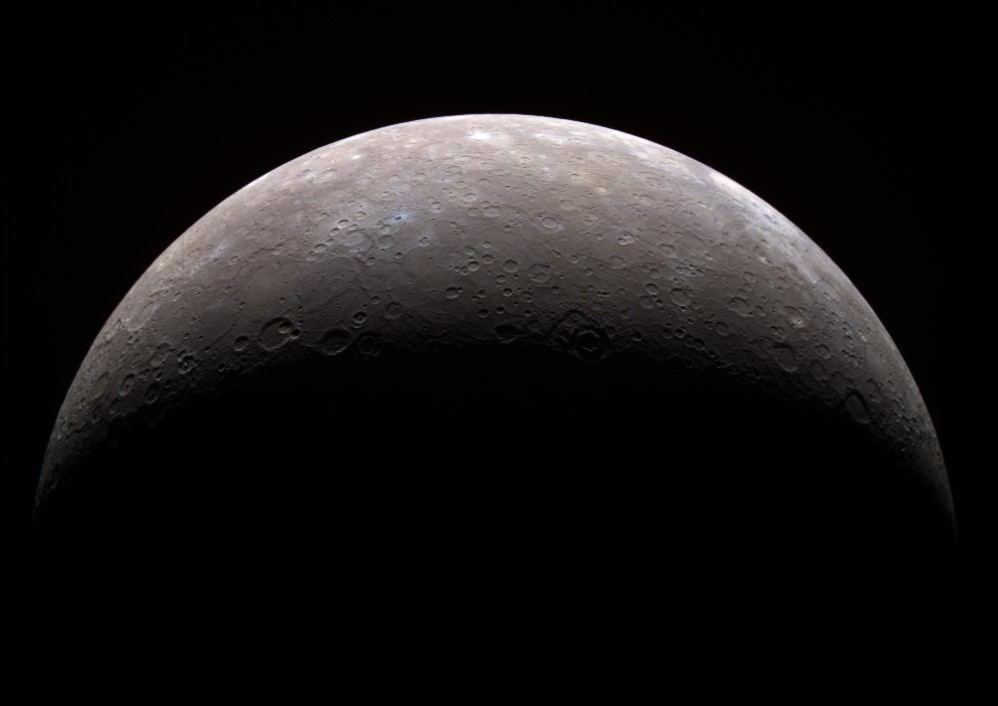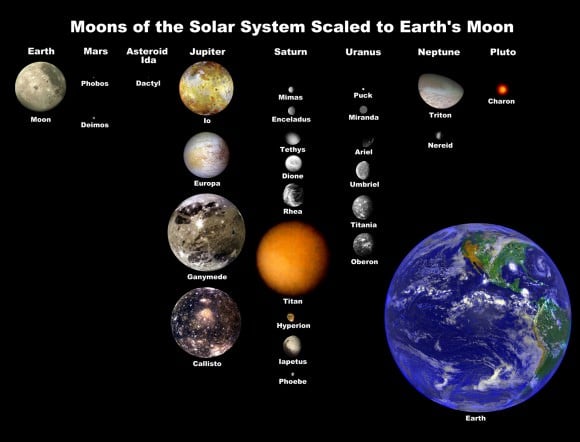Virtually every planet in the Solar System has moons. Earth has
The Moon
, Mars has
Phobos and Deimos
, and
Jupiter
and
Saturn
have 67 and 62 officially named moons, respectively. Heck, even the recently-demoted dwarf planet
Pluto
has five confirmed moons -
Charon
,
Nix
,
Hydra
, Kerberos and Styx. And even asteroids like
243 Ida
may have satellites orbiting them (in this case, Dactyl). But what about
Mercury
?
If moons are such a common feature in the Solar System, why is it that Mercury has none? Yes, if one were to ask how many satellites the planet closest to our Sun has, that would be the short answer. But answering it more thoroughly requires that we examine the process through which other planets acquired their moons, and seeing how these apply (or fail to apply) to Mercury.
To break it all down, there are three ways in which a body can acquire a natural satellite. These causes have been determined thanks to many decades of astronomers and physicists studying the various
moons of the Solar System
, and learning about their orbits and compositions. As a result, our scientists have a good idea of where these satellites came from and how they came to orbit their respective planets.
[caption id="attachment_126368" align="aligncenter" width="580"]
Montage of the Solar System's moons, shown to scale. Credit: planetary.org
[/caption]
Causes Of Natural Satellites:
First, a satellite (or satellites) may form from a circumplanetary disk of material that orbits a planet - similar to a
protoplanetary disk
around a star. In this scenarios, the disk gradually coalesces to form larger bodies, which may or may not be massive enough to undergo
hydrostatic equilibrium
(i.e. become spherical). This is how Jupiter, Saturn,
Uranus
and
Neptune
are believed to have acquired the majority of their larger satellites.
Second, satellites may be acquired when a small body is captured by the gravity of a larger body. This is believed to be the case where Mars' moons of Phobos and Deimos are concerned, as well as Jupiter, Saturn, Neptune's and Uranus' smaller, irregular moons. It is also believed that Neptune's largest moon,
Triton
, was once a
Trans-Neptunian Object
(TNO) that was ejected from the
Kuiper Belt
and then captured by Neptune's gravity.
Last, there is the possibility that moons are the result of massive collisions that caused a planet to ejected some of their material into space, which then coalesced to form a satellite in orbit. This is widely thought to be how The Moon was formed, when a Mars-sized object (often referred to as
Theia
) collided with it 4.5 billion years ago.
Hill Sphere:
Also known as a Roche Sphere, a
Hill Sphere
is a region around an astronomical body where it dominates the attraction of satellites. The outer edge of this region constitutes a zero-velocity surface - which refers to a surface a body of given energy cannot cross, since it would have zero velocity on the surface. In order to orbit a planet, a moon must have an orbit that lies within the planet's Hill Sphere.
In other words, a Hill Sphere approximates the gravitational sphere of influence of a smaller body in the face of perturbations from a more massive body (i.e. the parent star). So when dealing with objects in the Solar System, anything within a planet's Hill Sphere will be bound to that planet, whereas anything outside of it will be bound to the Sun.
A perfect example of this is Earth, which is able to hold The Moon in its orbit, in the face of the overwhelming gravity of the Sun, because it orbits within Earth's Hill Sphere. Alas, this is why Mercury has no moons of its own. Categorically, it is not in a position to form one, capture one, or acquire one from material ejected into orbit. And here's why:
Mercury's Size and Orbit:
Given Mercury's small size (the smallest planet in the Solar System) and its proximity to the Sun, it's gravity is too weak (and it's Hill Sphere too small) to retain a natural satellite. Basically, if a large object were to approach Mercury today, to the point that it actually entered its Hill Sphere, it would likely be snatched up by the Sun's gravity instead.
Another way in which Mercury could not have acquired a moon has to do with the scarcity of material in its orbit. This may be due to solar winds and the condensation radii of lighter materials, where trace substances like hydrogen and methane remained in gaseous form nearer to the Sun during Mercury's formation, and were thence swept away. This left only elements like iron and and nickel in solid form, which then coalesced to form Mercury and the other terrestrial planets.
For a time in the early 1970s, astronomers thought the Mercury might have a moon. Instruments on board NASA's
*Mariner 10*
spacecraft detected large amounts of ultraviolet radiation in the vicinity of Mercury that astronomers believed did not belong there. Hence, some theorized that this radiation was coming from a nearby moon. Unfortunately, the radiation disappeared the next day, and it was later discovered that the source was actually a distant star.
Alas, it seems that planets that are too close to the Sun, such as Mercury and Venus, are destined to be without natural satellites. It's a good thing then that we Earthlings were lucky enough to live on a world that is far enough from the Sun and has a big enough Hill Sphere to keep a satellite. We are also fortunate enough that the massive collision that created our Moon happened so long ago!
We've written several articles for Universe Today about Mercury. Here's an article about the
gravity on Mercury
, and
here are some facts on Mercury
. And here is an article that answers the question
How Many Moons Are In The Solar System?
If you'd like more info on Mercury, check out
NASA's Solar System Exploration Guide
, and here's a link to
NASA's MESSENGER Misson Page
.
We've also recorded an episode of Astronomy Cast all about Mercury. Listen here,
Episode 49: Mercury
.
 Universe Today
Universe Today

